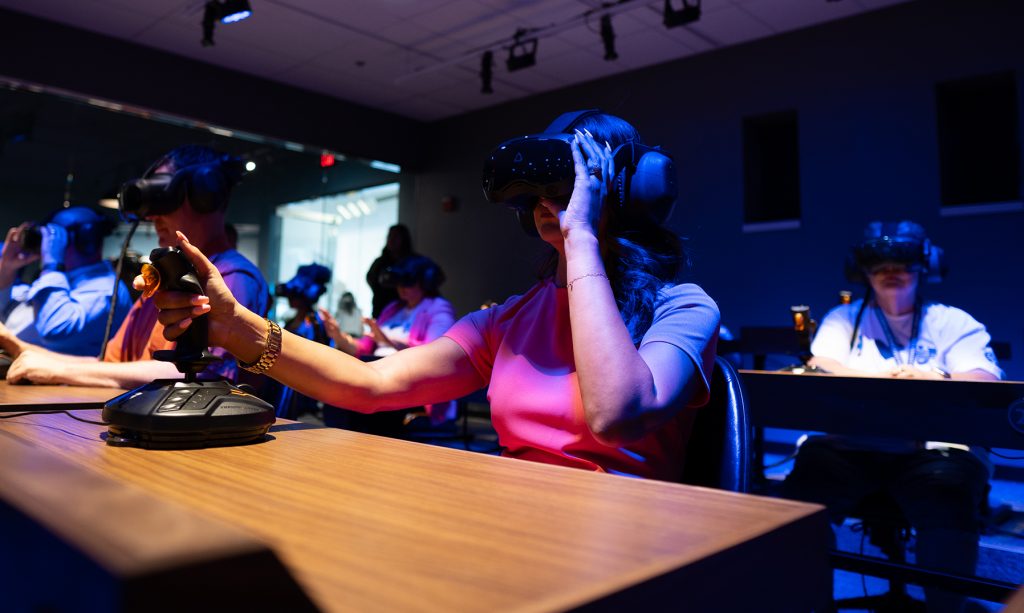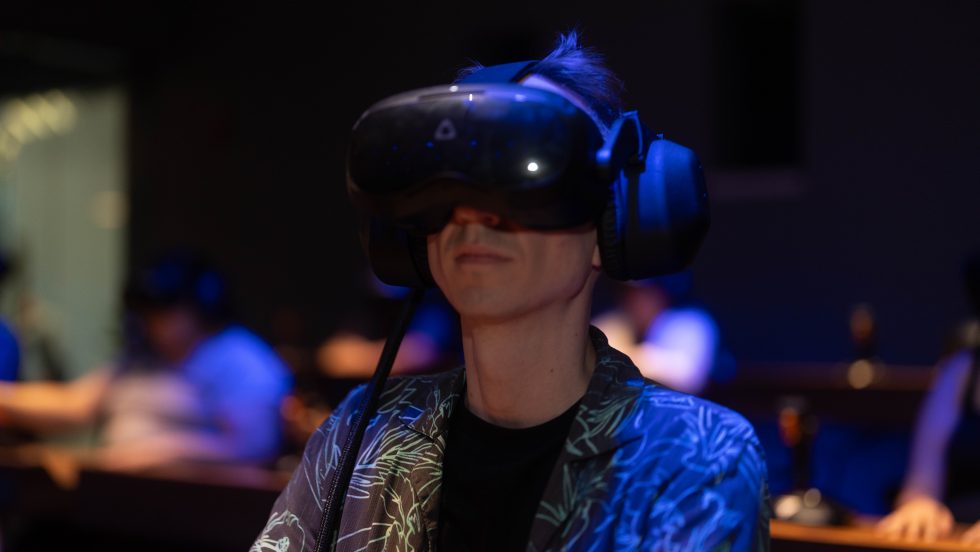“You’re traveling through another dimension, a dimension, not only of sight and sound, but of mind. A journey into a wondrous land whose boundaries are that of imagination. Your next stop …”
Well, it’s not 1960, and you’re not in the Twilight Zone. It’s 2024 and you’ve arrived instead at Merced College, where the portal into the future of learning is housed in the campus’s new Dreamscape Learn virtual reality lab.
Merced College is one of the first California Community Colleges and among fewer than 10 colleges nationwide to teach using the VR technology, which was pioneered in partnership with Arizona State University.
Putting virtual reality into students’ hands has supercharged their “education through exploration” experience.
“It’s a significant, powerful new tool,” Merced College Dean of Innovation Garrick Grace said. “Our end goal was to have a campus lab providing students with a significantly higher level of engagement. And you can’t get more engaged than when using the latest technology to experience a Hollywood-produced storyline. It’s a game-changer.”
Current Introduction to Biology students make weekly visits to the lab. Wearing VR headsets, they become research biologists immediately immersed into an intergalactic wildlife sanctuary and trying to figure out what is happening with “the astelars,” a species of cute sea turtle-like creatures on this virtual planet. Students quickly learn the astelars not laying enough eggs, putting their very existence at stake. But why?
The storyline rolls out through modules in which new characters and issues are introduced. The course is a multi-act play with an M. Night Shyamalan-like twist midway through the semester. Students are having fun, only halfway realizing how powerfully the story connects them to the real-world biology concepts.
“If we talked about turtles on a beach in class, and gave them some data, why would the students care about that?” Biology Professor Torey Arnold said. “They don’t. They didn’t do the legwork. At the VR lab, they do. And then they naturally ruminate on the questions being asked. We did a demo last month and it was a freakin’ blast.”
“You have to touch things and look for things. It makes you feel like you’re really doing something. Everything about it catches your interest.”
Amina Housini, Merced College Student
Freshman liberal studies and studio arts major Amina Housini had no idea she’d be among the first to experience a VR-driven education this semester. She did know she’d dropped out of biology before because it was so boring.
“I enjoy biology so much more now,” Housini said. “We’re scientists doing experiments on this alien beach. It was cool. You have to touch things and look for things. It makes you feel like you’re really doing something. Everything about it catches your interest.”
Arnold said he immediately noticed a lot less moaning and groaning from students during his first lesson last month.
“We’d heard from Arizona State that their students would get into heated discussions about what was happening with the sea turtles,” Arnold said. “I had never once seen that kind of passion in class before this. I’ve already noticed a big difference after a few weeks. When I’d review a lecture before, it was hard to get accurate responses. But when I review the VR labs now, it just pours out of them, because they experienced it. It sticks more.”
There are already VR modules for non-majors and a deeper version for biology majors. Merced College faculty has been able to pull lessons from the major curriculum or use other one-off scenarios as needed. Biology Professor Summer White said all of the lessons are also easily modified to increase or decrease the difficulty, to edit for time or to go deeper into a particular interest.
White, who is teaching four remote biology sections this semester, uses the same Dreamscape/ASU content except they’re presented via interactive 2D videos. Remote students feel more like they’re playing a video game, except the 2D doesn’t lose the storytelling hook at all.

“That triggers the ‘wow factor’ for many students,” White said. “It’s also nice to have the 2D for students who get motion sickness. They can still be involved in class really easily. I hope eventually we can bring to the lab remote students who want to experience the immersive VR.”
Faculty can also use the one-off VR scenarios, that take people through the rain forest, the Oval Office, the Colosseum and more, to engage students.
“I was ecstatic when I saw the VR at Arizona State last year, knowing there were so many things we can do,” White said. “For anatomy, we can drive a nanobot through the heart. Normally that structure is not tangible for students. How cool would it be then if we’re able to sit inside the nucleus when replication is occurring? When I found out that type of learning was possible, I was absolutely on board.”
About working in the immersive classroom, Housini added, “Everyone around you is doing the same thing. You don’t feel alone while learning. You might be having trouble yourself, but you can talk to anyone on your team about anything.”
Dreamscape and ASU are currently developing storylines for introductory curricula for chemistry and art history, which everyone hopes will be available for Fall 2025.
Inside the VR lab, there are also six development workstations were students will eventually create new content while gaining video game creation skills.
“We have faculty already asking for new missions in different disciplines, like health care and working with patients in a hospital room or dental office,” Grace said.
“Now that we’ve launched, it’s so cool to see the level of engagement from everyone on campus, and the community outreach we’ve been able to do. It’s been phenomenal. Leaders all over the state want to visit. We’re trying to provide as much access as we can so people can experience the potential of it.”
